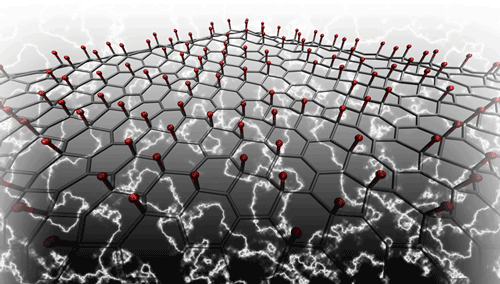Nanotech breakthrough: engineers develop piezoelectric graphene
Could further application research in electronics, photonics, energy harvesting, more
Stanford researchers have successfully engineered piezoelectrics into graphene, marking the first time such a high level of physical control has been extended to the nanoscale.

According to researchers, lithium atoms (red) adhered to a graphene lattice will produce electricity when bent, squeezed or twisted. Conversely, the graphene material will deform when an electric field is applied, opening new possibilities in nanotechnology.
Their paper was published in the journal ACS Nano . Here’s some background on the project:
Why’s graphene such a big hit with the nanotech community?
Graphene is, approximately speaking, a hundred times better conductor of electricity than silicon. It’s also stronger than a diamond and incredibly thin (just one micron thick, as a matter of fact). The unique physics of this material allow engineers to use it in applications that extend way beyond the limitations of other materials.
The benefits of piezoelectricity
Piezoelectricity is the property of a material’s ability to produce an electric charge when bent, squeezed, or twisted. It is reversible, which means when an electric field is applied, the piezoelectric material changes shape. This provides the user with a remarkably high level of control because the way the electrical field strains or deforms can be predicted.
Some of the more common applications where piezoelectricity is used include watches, radios, and ultrasound equipment.
A surprising discovery
Despite all of the many perks that come with using graphene, one thing that it could not support was piezoelectricity.
The way the Stanford team was able to get around this was through the use of a sophisticated modeling application that ran on high-performance supercomputers. Doing this allowed them to simulate the deposition of various atoms on one side of a graphene lattice, otherwise known as “doping”, and then measure the piezoelectric effect.
Over the course of their research, they modeled graphene doped with lithium, hydrogen, potassium, and fluorine. The team also used combinations of hydrogen / fluorine and lithium / fluorine on either side of the lattice. Doping just one side of the graphene, or doping both sides with different atoms, is what made the difference — it broke down the graphene’s perfect physical symmetry, which otherwise cancels the piezoelectric effect.
Naturally, these results surprised the engineers.
“We thought the piezoelectric effect would be present, but relatively small. Yet, we were able to achieve piezoelectric levels comparable to traditional three-dimensional materials,” said Evan Reed, head of the Materials Computation and Theory Group at Stanford and senior author of the study. “It was pretty significant.”
Mitchell Ong, a post-doctoral scholar in Reed’s lab and first author of the paper, reflected on what it means to the nanotech community, “Piezoelectric graphene could provide an unparalleled degree of electrical, optical or mechanical control for applications ranging from touchscreens to nanoscale transistors.”
The team took their discovery one step further, fine tuning the piezoelectric effect by pattern doping the graphene (as pictured in the illustration at the beginning of the article).
“We call it designer piezoelectricity because it allows us to strategically control where, when, and how much the graphene is deformed by an applied electrical field with promising implications for engineering,” said Ong.
What’s next?
While Reed and Ong recognize that creating piezoelectric graphene is encouraging, they believe that the technique could be further developed to one day engineer piezoelectricity in nanotubes and other nanomaterials. This would be useful in applications ranging from electronics, photonics, and energy harvesting to chemical sensing and high-frequency acoustics.
“We’re already looking at new piezoelectric devices based on other 2D and low-dimensional materials, hoping they might open new and dramatic possibilities in nanotechnology,” said Reed.
Engineered Piezoelectricity in Graphene article (for purchase) ■
Advertisement
Learn more about Electronic Products Magazine





